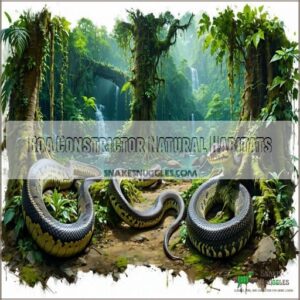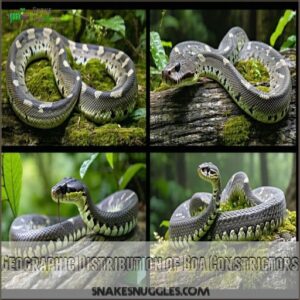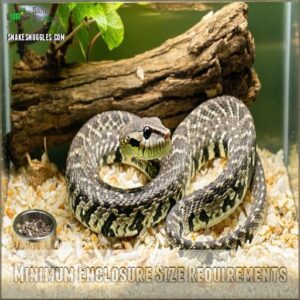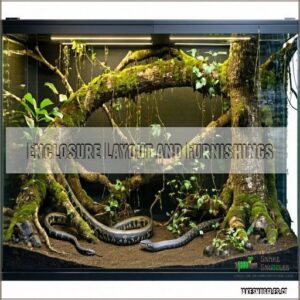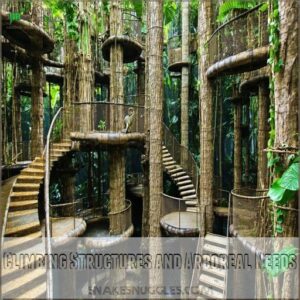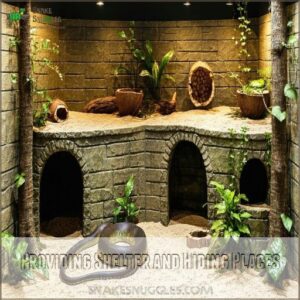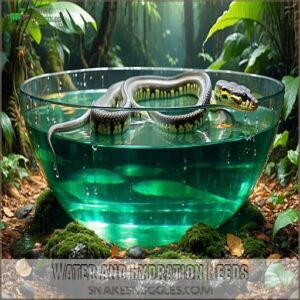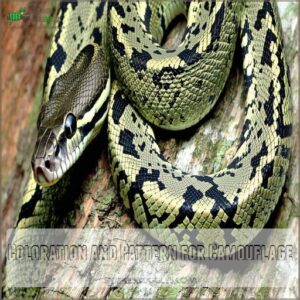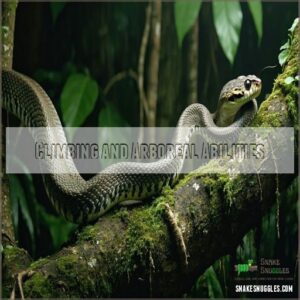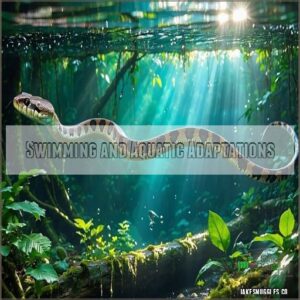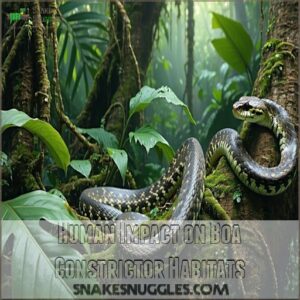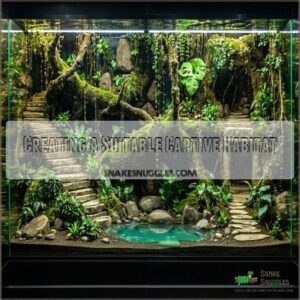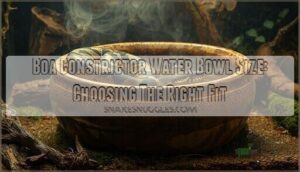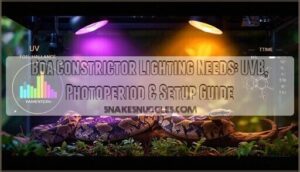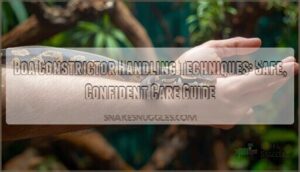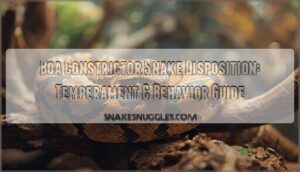This site is supported by our readers. We may earn a commission, at no cost to you, if you purchase through links.

Start with a spacious 4x2x2-foot enclosure that includes both climbing structures and ground space.
Maintain a temperature gradient from 80-90°F, with a basking spot on the warm end. Keep humidity between 50-60% using a large water bowl and regular misting.
You’ll want two hide boxes—one on each end—plus branches, cork bark, and secure plants for climbing and shelter.
Like a cozy apartment with climate control, your boa’s home should offer comfort zones for every mood. Understanding their natural behaviors reveals fascinating insights about optimizing their space.
Table Of Contents
- Key Takeaways
- Boa Constrictor Natural Habitats
- Geographic Distribution of Boa Constrictors
- Boa Constrictor Habitat Requirements
- Enclosure Size and Setup for Boas
- Providing Shelter and Hiding Places
- Water and Hydration Needs
- Boa Constrictor Adaptations and Needs
- Human Impact on Boa Constrictor Habitats
- Creating a Suitable Captive Habitat
- Frequently Asked Questions (FAQs)
- What do boa constrictors need in their habitat?
- What do boas need in their tank?
- What is the best enclosure for a boa constrictor?
- Are boa constrictors high maintenance?
- How often should I clean my boas water dish?
- Can boa constrictors share enclosures with other snakes?
- What substrate is safest during shedding periods?
- Should heat lamps stay on overnight?
- How long can boas go without environmental enrichment?
- Conclusion
Key Takeaways
- You’ll need a spacious 4x2x2-foot enclosure with both climbing structures and ground space to suit your boa constrictor’s natural behavior.
- Maintain a temperature gradient from 80-90°F, with a basking spot, and keep humidity between 50-60% to ensure your snake’s comfort.
- Create multiple hiding spots using hide boxes on both the warm and cool ends of the enclosure, and include secure plants for climbing.
- Regularly monitor and adjust temperature and humidity levels; provide fresh water and a clean environment to promote your snake’s health and well-being.
Boa Constrictor Natural Habitats
You’ll find boa constrictors thriving in diverse environments across Central and South America, from lush tropical rainforests to arid grasslands and semi-deserts.
In these natural habitats, they’ve adapted to become skilled climbers and swimmers.
Using their remarkable abilities to hunt prey and find shelter in trees, ground cover, and even around water sources.
Tropical Rainforests and Forests
In the depths of tropical rainforests, boa constrictors thrive among the dense forest canopy and understory life.
You’ll find these remarkable snakes perfectly adapted to life in multiple forest layers, from the rainforest floor to towering branches.
Their natural habitat provides ideal conditions: high humidity, stable temperatures, and abundant prey.
Despite climate change impacts, tropical rainforests remain essential for wild boa populations, offering shelter and hunting grounds year-round.
Grasslands and Savannas
Many boa constrictors thrive in grassland and savanna environments, where scattered vegetation provides perfect hunting grounds.
You’ll find these adaptable snakes moving through tall grasses and using isolated trees as lookout points.
They’re masters at finding prey like rodents and birds in these open landscapes, while taking advantage of termite mounds and abandoned burrows for shelter. Ideal thermal regulation opportunities are created by the mix of open spaces and vegetation.
Dry Forests and Semi-Deserts
While boa constrictors face unique challenges in dry forests and semi-deserts, they’ve mastered survival in these harsh environments.
They’ve developed remarkable camouflage adaptations that blend with sandy terrain and sparse vegetation.
In these arid habitats, they’ll often seek shelter under rocks or in burrows, emerging during cooler periods to hunt available prey. You’ll find these adaptable reptiles thriving despite water scarcity and thermal challenges. boa constrictors
Riparian Areas and Aquatic Environments
Boa constrictors thrive near water sources, from peaceful streams to bustling river banks.
These riparian zones offer unique advantages – abundant prey, perfect humidity levels, and natural shelter.
You’ll find them traversing waterways with surprising grace, using their muscular bodies to swim and hunt. Their ability to adapt between wet and dry environments showcases their remarkable versatility in these water-rich habitats. Boa constrictors are remarkably versatile.
Geographic Distribution of Boa Constrictors
You’ll find boa constrictors thriving across Central and South America, from Mexico’s tropical forests to Argentina’s diverse landscapes, as well as throughout the Caribbean islands.
While they’re primarily native to these regions, you should know that some populations have been introduced to Southern California, where they’ve adapted to the local environment.
Central America and Caribbean Islands
Throughout Central America and the Caribbean islands, you’ll find fascinating boa constrictors thriving in diverse habitats. These remarkable snakes have adapted to various environments, each offering unique challenges and opportunities.
Here’s what makes these regions special:
- Dense rainforests provide perfect hunting grounds
- Coastal mangroves offer excellent camouflage opportunities
- Mountain regions support distinct island subspecies
- Protected reserves help maintain vulnerable populations
Let’s explore how these adaptable creatures manage to flourish across such varied terrains.
South America and Subspecies Variations
Living across South America’s diverse landscapes, from Brazil’s lush Amazon to Argentina’s dry forests, you’ll find fascinating variations in boa constrictor populations.
These remarkable snakes showcase distinct morphs and genetic diversity shaped by their local environments.
You’ll notice different patterns and sizes among subspecies, with some preferring dense rainforest canopies while others thrive in more open habitats. Their conservation status varies by region.
Introduced Habitats in Southern California
While South American boas thrive in their native jungles, you’ll find an unexpected population in Southern California.
Those interested in learning more about these boas and their products can find more information through Southern California boa products.
These introduced boas have established themselves in areas like San Diego County, where they’re raising concerns among wildlife experts.
They’re affecting local ecosystems and native species, prompting careful monitoring and control efforts.
If you spot one, it’s best to report it to local wildlife authorities.
Boa Constrictor Habitat Requirements
You’ll need to create a carefully controlled environment that matches your boa constrictor’s natural habitat, including specific temperature ranges, humidity levels, and proper lighting.
Your setup must include the right substrate, multiple hiding spots, and enough space for your snake to stretch out and explore, ensuring it stays healthy and active in captivity. boa constrictor’s natural habitat healthy and active in captivity
Temperature Ranges and Gradients
In the wild, boa constrictors masterfully regulate their body temperature across diverse habitats.
To recreate this in captivity, you’ll need two distinct zones: a basking spot of 85-90°F and a cooler area around 80°F.
Your setup should include a reliable heat source (like ceramic emitters or under-tank heaters) and multiple temperature zones.
This thermal gradient lets your boa move between areas to control its body temperature naturally.
Humidity Levels and Control Methods
Maintaining proper humidity keeps your boa constrictor healthy and comfortable. Just like temperature control, humidity management requires careful attention, especially during shedding cycles, which require occasional spikes of up to humidity for shedding cycles.
Here’s how to keep those moisture levels perfect:
- Monitor with a digital hygrometer placed at ground level
- Mist enclosure walls and substrate 1-2 times daily
- Use moisture-retaining substrates like coconut fiber or cypress mulch
- Provide a large water bowl that allows soaking
These methods help maintain the ideal 50-60% humidity your boa needs to thrive. Regular substrate changes and proper ventilation prevent mold growth while keeping moisture levels stable.
Lighting and Photoperiod Needs
Setting up proper lighting for your boa constrictor isn’t just about illumination—it’s about mimicking their natural day-night cycle.
You’ll want to maintain a consistent 12-hour light cycle using LED or fluorescent bulbs that won’t add extra heat to the enclosure.
While UVB lighting isn’t essential for boas, some keepers report improved activity levels and natural behaviors when providing low-level UVB exposure.
Substrate Options and Safety Considerations
Choosing the right substrate for your boa constrictor isn’t just about looks—it’s essential for their health and well-being. You’ll want something that maintains humidity while being easy to clean and safe for your snake.
- Newspaper or paper towels: Perfect for quarantine or medical monitoring
- Coconut fiber (coco husk): Excellent humidity retention and burrowing potential
- Cypress mulch: Natural look with good moisture control
- Reptile carpet: Easy to clean but watch for loose threads
Enclosure Size and Setup for Boas
You’ll need an enclosure at least 4x2x2 feet for your adult boa constrictor, though bigger is always better for these impressive snakes.
Your boa’s home should include essential features like proper heating (78-88°F), adequate humidity (50-60%), and sturdy climbing structures to keep your scaly friend healthy and active.
Minimum Enclosure Size Requirements
The right enclosure size makes all the difference for your boa constrictor’s health and happiness.
According to expert guidelines, a boa constrictor enclosure size should be adapted to the snake’s growth, ensuring proper ventilation, substrate depth for burrowing, and adequate lighting, which can be found in more detail in boa constrictor enclosure size guidelines.
Here’s what you’ll need based on your snake’s size:
| Snake Length | Minimum Size | Recommended Size | Height | Notes |
|---|---|---|---|---|
| Baby ( |
Enclosure Layout and Furnishings
Your boa’s enclosure layout needs careful planning to create a comfortable home.
Start with a secure, well-ventilated enclosure.
Place two hide boxes – one on the warm side and another on the cool side. Add a sturdy water bowl large enough for soaking, and choose safe substrate like coconut fiber or cypress mulch.
Position your heating elements strategically to maintain proper temperature gradients.
Climbing Structures and Arboreal Needs
Providing climbing structures satisfies your boa’s natural arboreal instincts and enriches their daily life.
Here’s what you’ll need to create an engaging vertical playground:
- Sturdy branches at varying heights (2-4 inches thick) securely anchored to prevent accidents
- Cork bark tubes offering both climbing opportunities and hiding spots
- Artificial vines creating natural pathways between perches
- Elevated platforms or ledges for basking and exploration
Providing Shelter and Hiding Places
You’ll need to create multiple hiding spots in your boa’s enclosure to help them feel secure and regulate their body temperature effectively.
Just like you’d want a cozy spot to retreat after a long day, your boa needs at least two hide boxes placed at different temperature zones.
along with visual barriers like artificial plants or branches.
Hide Boxes and Visual Barriers
Strategic placement of hide boxes gives your boa constrictor essential security zones in their enclosure.
You can find a variety of boa hide boxes online at stores like boa hide options.
You’ll need at least two hide boxes – one for the warm side and another for the cool side. Opt for snug-fitting boxes where your snake can touch all sides when coiled up.
Visual barriers like cork panels or bamboo screens create additional privacy zones, reducing stress and promoting natural behaviors.
Plant Life and Natural Shelter
Beyond hide boxes, live or artificial plants create a more naturalistic environment for your boa constrictor.
Snake-safe options like pothos, snake plants, and philodendrons offer additional cover while maintaining proper humidity.
Make sure to secure plants firmly and choose non-toxic varieties.
You’ll want to position foliage strategically near basking spots and water dishes, giving your boa choices for both concealment and exploration.
Creating a Temperature Gradient
A well-designed temperature gradient mimics your boa’s natural habitat shifts between sun and shade.
Set up your heat mat or ceramic heater on one end of the enclosure to create a basking spot of 88-92°F.
Let the temperature gradually decrease to 75-80°F at the cool end. This setup lets your boa regulate its body temperature naturally, just like in the wild.
Water and Hydration Needs
You’ll need to meet your boa constrictor’s hydration needs by providing both a large water bowl for drinking and soaking, and maintaining proper humidity levels between 50-60%.
While your snake mightn’t drink often, you’ll want to keep fresh, clean water available at all times since it’s essential for their health and helps with shedding.
Water Bowl Size and Placement
After creating cozy hiding spots, you’ll need a robust water bowl for your boa constrictor.
Choose a heavy-duty bowl that’s 1.5 times your snake’s coiled width and deep enough for soaking.
Position it on the cool side of the enclosure, away from the basking area. A sturdy ceramic or plastic bowl works best – you’ll want something that won’t tip when your boa decides to take a dip.
Maintaining Proper Humidity Levels
You’ll need to maintain humidity levels between 50-60% for your boa constrictor’s best health.
Monitor constantly with a digital hygrometer placed at mid-level height.
Regular misting with dechlorinated water, especially during shed cycles, helps maintain proper levels.
Humidity-holding substrates like coconut fiber or cypress mulch create a natural moisture gradient.
Consider automated misting systems for consistent humidity control.
Providing a Water Source for Soaking
A properly sized water bowl lets your boa constrictor soak comfortably.
You can find a wide variety of suitable bowls, such as those available from a reputable online retailer, to guarantee your snake has ample space.
Select a bowl that’s wide enough for your snake to coil inside and deep enough to submerge about half its body.
Keep the water clean and fresh, changing it daily to prevent bacterial growth.
Place the bowl on the cooler side of the enclosure, away from heat sources to minimize evaporation and maintain water quality.
Boa Constrictor Adaptations and Needs
You’ll find that boa constrictors have evolved remarkable features to help them thrive, from their muscle-powered climbing abilities to their distinctive camouflage patterns that blend with forest environments.
Whether you’re providing branches for climbing or creating temperature zones that match their natural habitat, understanding these adaptations will help you create the perfect environment for your boa.
To showcase its natural behaviors.
Coloration and Pattern for Camouflage
Boa constrictors showcase remarkable pattern variations that serve as their natural defense system.
These snakes display intricate color morphs, from earthy browns to vibrant reds, helping them blend seamlessly with their surroundings.
Their genetic makeup determines these patterns, which have evolved over millennia for predator avoidance. Their genetic makeup
In the wild, you’ll spot how their scales create a stunning mosaic that mirrors forest floors and tree bark. predator avoidance
Climbing and Arboreal Abilities
While their impressive camouflage helps them blend in,
it’s their climbing abilities that truly shine. Young boa constrictors are especially talented climbers, gracefully traversing branches and vines in search of prey.
As they grow larger, they’ll still maintain these skills, though adults tend to be more ground-dwelling.
Their muscular bodies and rough scales provide excellent grip, letting them explore different heights in their environment.
Swimming and Aquatic Adaptations
These powerful swimmers glide through tropical waters with remarkable grace, showcasing their adaptability in both terrestrial and aquatic environments.
Like underwater acrobats, they’ve mastered essential swimming skills that serve multiple purposes: traversing through the humid environments of their tropical rainforest habitats, with humidity levels ranging from 55-75%.
- Traversing flooded habitats during seasonal rains
- Pursuing aquatic prey like fish and amphibians
- Crossing rivers and streams to explore new territories or escape threats
These adaptations help them thrive in diverse ecosystems, from rainforest streams to coastal mangroves.
Human Impact on Boa Constrictor Habitats
You’ll find that human activities, including deforestation and urban expansion, have dramatically changed the natural homes of boa constrictors across Central and South America.
As you explore their habitat requirements, you’ll learn how agricultural development and city growth continue to fragment their territories.
Making it essential to understand both their natural environment and conservation needs.
Deforestation and Habitat Loss
The destruction of pristine rainforests has left boa constrictors facing unprecedented challenges. You’ll find these remarkable creatures struggling to adapt as their homes vanish at an alarming rate.
Here’s what’s happening to their habitats:
| Impact | Current Status | Solutions |
|---|---|---|
| Logging | Heavy losses | Sustainable practices |
| Resources | Declining | Wildlife corridors |
| Population | Decreasing | Protected areas |
| Food Sources | Limited | Habitat restoration |
| Territory | Fragmented | Community programs |
They’re losing hunting grounds, shelter, and breeding sites to unchecked deforestation.
Agricultural Expansion and Fragmentation
Agricultural expansion slices through boa constrictor territories like a knife through butter.
Growing farmland fragments their once-continuous habitats into isolated patches, making it harder for boas to find mates and maintain genetic diversity.
Pesticides and fertilizers seep into their environments, poisoning both the snakes and their prey. When farmland divides habitats, it’s like building walls between snake communities, threatening their long-term survival. Pesticides and fertilizers seep into their environments, poisoning both the snakes and their prey. Agricultural expansion is a significant threat.
Urban Development and Conservation Efforts
Expanding cities slice through boa constrictor territories like a knife through butter, creating unique conservation challenges.
Urban development impacts these magnificent creatures in several ways:
- Increased roadkill risk along new highways
- Habitat fragmentation from housing developments
- Light pollution disrupting natural behaviors
- Human-snake conflicts in suburban areas
- Reduced genetic diversity due to isolated populations
Conservation efforts focus on sustainable development and community involvement, balancing urban growth with wildlife protection through wildlife corridors and protected zones.
Creating a Suitable Captive Habitat
You’ll need to recreate your boa constrictor’s natural habitat by maintaining proper temperature gradients of 78-88°F and humidity levels of 50-60% in an enclosure that’s at least 4x2x2 feet for adults.
Once you’ve set up the basics, you’ll want to add climbing branches, hiding spots, and a large water dish to keep your snake comfortable and enriched in its new home.
Replicating Natural Environments
Creating a captive home that mirrors your boa’s natural environment isn’t just about aesthetics – it’s about promoting their well-being.
You’ll want to focus on three key elements: proper temperature gradients (78-88°F), consistent humidity levels (50-60%), and appropriate substrate choices.
Mix coconut fiber or cypress mulch for a natural feel, and remember that good ventilation keeps both you and your snake healthy.
Providing Enrichment and Stimulation
Thoughtful enrichment keeps your boa constrictor mentally stimulated and physically active.
By recreating their natural environment, you’ll help them thrive in captivity.
Here’s what your snake needs:
- Multiple climbing branches at different heights for exploration
- Puzzle feeders that challenge hunting instincts
- Live, non-toxic plants for sensory stimulation
- Various hide boxes placed strategically throughout warm and cool zones
Regular Maintenance and Monitoring
Every boa constrictor habitat requires a solid maintenance schedule, including a well-ventilated and escape-proof enclosure to prevent stress and create a healthy environment learn how to house a snake.
You’ll need to clean the enclosure every 4-6 weeks, spot clean daily, and monitor temperature and humidity levels twice daily.
Keep a log of your snake’s weight, feeding schedule, and shed cycles.
Watch for behavior changes that might signal health issues.
Regular parasite checks and disinfecting equipment help prevent potential problems.
Frequently Asked Questions (FAQs)
What do boa constrictors need in their habitat?
Like a cozy jungle retreat, your boa’s habitat needs temps of 78-88°F, and 50-60% humidity.
A 4x2x2 foot enclosure is recommended.
Proper substrate, hiding spots, and climbing structures are also necessary.
Don’t forget UVB lighting and a large water dish.
What do boas need in their tank?
Your boa’s tank needs temperatures of 78-88°F, and 50-60% humidity.
a 4x2x2-foot minimum space.
Proper substrate, heating elements, a large water dish, climbing structures, and two hide boxes are also needed for best well-being.
What is the best enclosure for a boa constrictor?
Adult boas need an enclosure at least 8x3x2-3 feet.
Proper heating (85-90°F basking area) and 60-70% humidity are required.
Multiple hide boxes and sturdy climbing structures are also necessary.
A secure lid and substrate like coconut husk are essential.
Are boa constrictors high maintenance?
Compared to other snakes, boas aren’t too demanding.
You’ll need to maintain proper temperature, humidity, and a spacious enclosure.
plus regular feeding and cleaning.
With the right setup, they’re relatively straightforward to care for.
How often should I clean my boas water dish?
Fresh, sparkling water is absolutely essential for your pet’s well-being!
You’ll need to clean the water dish daily, replacing it with fresh water.
Additionally, give it a thorough scrub with soap weekly to prevent bacteria growth.
Can boa constrictors share enclosures with other snakes?
You shouldn’t house boa constrictors with other snakes.
They’re solitary animals that may attack, eat, or stress each other out.
Even same-species cohabitation can lead to competition for resources and potential injury.
What substrate is safest during shedding periods?
During shedding, keep your snake’s skin supple with cypress mulch or coconut fiber substrate.
They’ll naturally rub against these moisture-retaining materials.
This makes the process smoother while preventing scale damage or infection.
Should heat lamps stay on overnight?
Heat lamps shouldn’t stay on overnight for boas.
Instead, use ceramic heat emitters or under-tank heaters to maintain a night temperature drop.
This mimics their natural environment, helping regulate their metabolism and provides restful conditions.
How long can boas go without environmental enrichment?
Boas can endure a few weeks without enrichment, but it’s not ideal.
Lack of stimulation might induce stress or boredom, affecting health.
Regular environmental changes, like adding climbing branches or puzzle feeders, help maintain their well-being.
Conclusion
Crafting the ideal habitat for a boa constrictor is like painting a detailed masterpiece, capturing the essence of their natural environment.
By mastering the boa constrictor’s habitat requirements, you guarantee your snake thrives with ideal temperature, humidity, and space.
Remember, mimicking their wild settings in captivity enriches their lives.
With the right setup, your boa can exhibit natural behaviors, offering you a glimpse into their fascinating world and contributing to their overall well-being and longevity.

